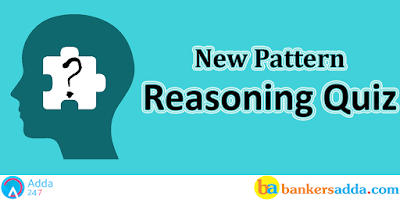Reasoning is a game of wits and presence of mind! Yes, it is true and it might seem as the greatest of the challenge after English Section’s surprises but yet this one can easily be dealt with. You just need correct practice and hardwire your brain to quickly make decisions of what to attempt and what to leave. And for same we are providing you questions of Reasoning Question. To Practice more with these new pattern Reasoning Question for RRB PO Exam 2017.
Directions (1-5): In the following questions the symbols $, #, @, % and * are used with the following meanings illustrated as below:
‘A $ B’ means ‘A is not smaller than B’.
‘A # B’ means ‘A is neither greater than nor equal to B’.
‘A @ B’ means ‘A is neither smaller than nor equal to B’.
‘A % B’ means ‘A is not greater than B’.
‘A* B’ means ‘A is neither greater than nor smaller than B’.
In each of the following questions assuming the given statements to be true, find out which of the three conclusions I, II and III given below them is/are definitely true and indicate your answer accordingly.
Q1. Statements:
D * Q, Q @ L, L $ B, B # G
Conclusions:
I. D @ B
II. B * D
III. G @ L
(a) Either I or II only
(b) I and II only
(c) I only
(d) II and III only
(e) None is ture
Q2. Statements:
Z @ Y, Y # K, K % M, M @ T
Conclusions:
I. Z @ M
II. Y @ T
III. Z # K
(a) I only
(b) II and III only
(c) Either I or III only
(d) All I, II and III
(e) None of true
Q3. Statements:
P # M, M % R, R * T, T # L
Conclusions:
I. P # R
II. P * R
III. M % L
(a) I only
(b) Either I or II only
(c) III only
(d) All I, II and III
(e) None is true
Q4. Statements:
F @ H, M % H, M $ R, G * M
Conclusions:
I. F $ R
II. F @ R
III. H $ G
(a) II and III only
(b) II only
(c) III only
(d) III and either I or II
(e) None is true
Q5. Statements:
K @ T, T # D, D * F, F % G
Conclusions:
I. G @ K
II. G* T
III. G @ T
(a) I and II only
(b) II and III only
(c) Either II or III only
(d) III only
(e) None is true
Directions (6-10): Study the following information carefully and answer the questions that follow.
Eight persons – A, B, C, D, E, F, G and H are sitting around a circular table, not necessarily in the same order. Four of them are facing inside and others are facing outside. They are belonging to eight different cities i.e. Raghopur, Kanpur, Itawa, Agra, Goa, Vaishali, Meerut and Ahmedabad, but not necessarily in the same order.
F faces the Centre and sits third to the right of C. D belongs to Itawa and faces the person who belongs to Vaishali. G sits third to the right of B, who stays in Raghopur. The persons who belong to Agra and Goa are facing to the same direction (inside or outside). E is sitting between the person who belongs to Itawa and the one from Ahmedabad respectively. A belongs to Goa and C belongs to Kanpur. The person who belongs to Meerut is facing outward and both the immediate neighbors of F facing outside. F belongs to Ahmedabad. H is an immediate neighbour of the persons who belong to Goa and Meerut. E is immediate left of D.
Q6. Who belongs to Vaishali?
(a) A
(b) D
(c) H
(d) G
(e) E
Q7. Immediate neighbors of A?
(a) B and C
(b) E and D
(c) H and B
(d) G and E
(e) D and F
Q8. Which of the following pair is true?
(a) A – Raghopur
(b) H – Vaishali
(c) D – Agra
(d) F – Agra
(e) G – Kanpur
Q9. Position of B with respect to E?
(a) Third to the right
(b) Fourth to the left
(c) Fourth to the right
(d) Second to the right
(e) Third to the left
Q10. If D and H interchange their positions and similarly F and C interchange their positions then what is the position of A with respect to new position of C?
(a) Third to the left
(b) Third to the right
(c) Second to the left
(d) Immediate left
(e) None of these
Directions (11-13): In each question below is given a statement followed by two assumptions numbered I and II. An assumption is something supposed or taken for granted. You have to consider the statement and the following assumptions and decide which of the assumptions is/are implicit in the statement.
Give answer
(a) if only Assumption I is implicit
(b) if only Assumption II is implicit
(c) if either Assumption I nor II is implicit
(d) if neither Assumption I nor II is implicit
(e) if both Assumption I and II are implicit
Q11. Statement: The government has recently announced additional food for work programmes for all the drought affected regions in the country.
Assumptions
I. The government has adequate funds to run these programmes.
II. Affected people may be able to get at least one meal a day due to these programmes.
Q12. Statement: Most of the engineering colleges in the state applied to the regulatory body for sanctioning more number of seats for the next academic session.
Assumption
I. The regulatory body may grant additional seats sought the engineering colleges of the state.
II. The engineering colleges of the state may get adequate number of applications to fill in the additional seats.
Q13. Statement: In view the severe heat wave passing through the state, the government has asked all the schools to remain closed for the next fortnight with immediate effect.
Assumptions
I. The heat wave may not continue beyond a fortnight.
II. The parents of the students may not allow their wards to attend even after a fortnight.
Directions (14 -15): Read the following information carefully and answer the questions which follow.
Roy starts from point A, walks 14 m towards the East, takes a left turn and walks 4 m. He then takes right turn, walks 2 m and stops.
Keith starts from the same point A, walks 14 m towards the South, takes a left turn and walks 20 m before stopping.
Q14. Roy walks 4 m from the point where he stopped in a straight line in the same direction which he faced when he stopped and reaches point B. How far would Keith have to travel from the point where he stopped and in which direction if he must meet Roy at point B?
(a) 12 m towards South
(b) 14 m towards South
(c) 18 m towards South
(d) 18 m towards North
(e) 16 m towards South
Q15. If Roy takes a right turn from the point where he stops walks 18 m and stops, how far would he be from the position where Keith stopped?
(a) 4 m
(b) 2 m
(c) 12 m
(d) 18 m
(e) 14 m




 Reasoning Quiz For Bank Foundation 2024 ...
Reasoning Quiz For Bank Foundation 2024 ...
 Reasoning Quiz For Bank Foundation 2024 ...
Reasoning Quiz For Bank Foundation 2024 ...



